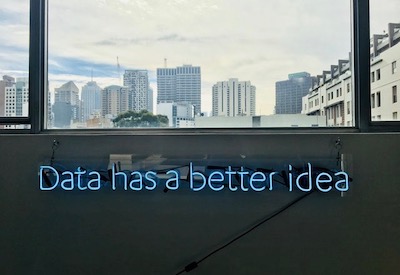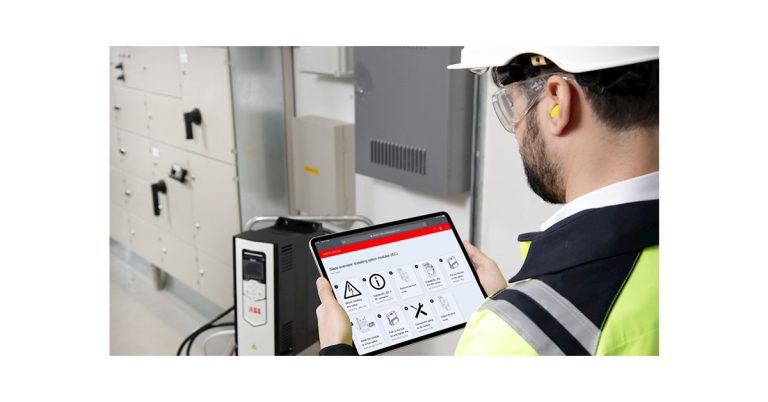AI: Construction’s New Frontier of Digital Enablement

Feb 11, 2021
By Erica Crandon, Giselle Chanona, Eric Ottinger, Todd Lukesh and Mark Gibson
For years, construction has lagged behind other industries regarding technological advancement, disruption and digital automation. Finally, this is starting to change. The reducing cost of digital enablement, staffing challenges and the increasing complexity of business is forcing disruption upon the industry. Of all the digital technologies, automation holds out the most promise for achievable digital enablement. Automation can be defined as the use of machines and computers that perform tasks without needing human control. This approach provides an extraordinary capability to process and organize massive quantities of data in a fraction of time compared to manual execution while operating 24 hours per day.
Initial investment is required. However, benefits delivering quality and insights are realized in a short period of time. We have seen companies that invest in automation have
• reduced processing time by up to 98%
• reduced front-line full-time employees by up to 64%
• reduced back office full-time employees by up to 47%
• reduced employee time by up to 50%
• reduced transaction turnaround time by up to 50%
• reduced OPEX costs by up to 35%
• reduced inventory levels by up to 10%
• removed error rates to achieve 100% accuracy
• identified thousands of duplicate invoices and suppliers in its ERP
• enabled clear accountabilities and data stewardships to sustain data integrity and trust
With these advancements bring new challenges of turning an influx of information into action. Identifying the right processes and tasks that can be automated while executing proper change management is critical. One of the most cutting-edge forms of technology that offers a tactical solution is Artificial Intelligence (AI).
There are three key applications of AI throughout a construction project. The first is utilizing AI in planning — preparing for construction using design and production modelling. Following sequence in a project; AI monitors progress throughout the build phase and predicts risk before it occurs. Finally, operations utilize AI to map cross-functional processes in real-time to produce insights for strategic decision-making.
This paper explores how AI can optimize and improve process-driven operations across each phase of a construction project lifecycle.
AI leads the charge
In generic terms, AI is a technology that responds to environmental stimuli and then adapts its processing to improve the actions taking place. AI models are trained on data in an iterative process by trial and error, making adjustments using rule-based mechanisms. These rules are designed to mirror characteristics associated with human behavior to effectively reason and self-correct – at an exponential level. For example: reading of an invoice. Initially the automated system cannot track or even recognize key pieces of information such as an address. However, over time, it learns by applying simple rules that categorize invoice information which can further be used for applications such as fraud detection or risk profiling.
Similar to how humans utilize different parts of the brain to solve problems, AI subsets have been developed that specialize in desired applications. The following section outlines the core subsets of AI that are most commonly deployed.
Machine learning (ML)
Machine learning is a form of AI that can perform a specific task without being explicitly programmed, instead relying on patterns and inferences. Large data sets are collected quickly and cleansed in a structured sequence of steps using networks to determine relevancy and improve accuracy with each datapoint, providing additional layers of intelligence (see prior address example for a form of machine learning). The machine operates on diversified learning patterns (supervised, unsupervised or reinforcement) to accomplish a desired task most efficiently. Machine learning platforms have become foundational to real-time predictive analytics that allow users to better mitigate risks and monitor controls.
Natural language processing (NLP)
Natural language processing is a function of AI that enables computers to structure, interpret and understand human language. NLP is typically used to collect and categorize content, and then analyze intent. This makes it possible for computers to extract keywords and phrases from either speech or text, understand the content and generate a response.
It enables efficient mining of relevant information to perform tasks such as compliance reviews, contract evaluations and even deploy chat-driven interfaces. An example is a ‘chat bot’, those creatures that pop up when visiting a website and ask you questions. By the way, if you thought they were real and operated by real people – sorry, those are chat bots using AI to communicate with you.
Computer vision
Computer vision is a form of AI that trains computers to interpret and understand the visual world. These machines accurately identify and locate objects through digital images. This technology is most commonly found in equipment, such as cameras and videos, that break down images into organized clusters of pixels through pattern recognition. Applications are diverse and can include surveillance, facial recognition, 3D modeling and automotive safety.
Physical robots
Physical robots combine computer science and engineering to accomplish physical tasks typically performed by humans. Traditionally, robots can lift or move predetermined objects in a specified trajectory. When fitted with IoT-enabled sensors and AI, robots can track an object regardless of its location in the working space. Similarly, an AI- enabled robot can maneuver through a path of travel using pre-programmed maps to detect obstacles and pivot as needed. Applications, such as autonomous bulldozers and cranes, can significantly reduce time and labor requirements to streamline construction operations and improve safety on site.
Robotic process automation (RPA)
RPA is used to replace repetitive and mundane tasks – typically tasks related to project controls, finance, building operations and maintenance. Automation takes a current or modified process and enhances this via the use of digital tools and AI, enabling machines (computers) to undertake the work previously executed by humans. It improves speed, accuracy, consistency and cost of executing these routine tasks.
RPA ‘bots’ collect data from multiple systems in a repetitive, auditable and controlled manner. NLP is then used to structure, categorize and interpret text derived from the bots to ultimately identify non- compliant activity. ML-based algorithms are also used alongside the bots to build forecasts based on past and present data. In this way, business processes can be fully automated to monitor and reduce costs, save time and enable data-driven decision making.
Transforming design and construction across the asset lifecycle
As referenced in “Technological advancements disrupting the global construction industry”, the global AI construction market is forecasted to grow substantially, from $407.2m in 2018 to $1.8b by 2023, at a compound annual growth rate of 35.1%.1 This growth expectation can largely be attributed to AI’s ability to expedite laborious, repetitive tasks common across construction projects. When applied across all stages of an asset’s lifecycle, the benefits grow substantially.
The following section tells a story, in the not-too-distant future, that describes how innovation through AI and big data will be implemented across the construction asset lifecycle. We envision these solutions as enablers, hybrid or truly disruptive that will bring transparency, single source of truth and confidence to the supply chain.
Planning and design
At the inception phase of any construction project, developers and engineers evaluate the site to outline critical planning and procurement parameters. To expedite the process, drones or unmanned aerial vehicles (UAVs) are utilized to conduct measurements and produce surveys. Capturing photo and video-based documentation, the architect can convert aerial images into fully rendered building information models (BIM). By incorporating BIM with AI powered software, designers significantly reduce the time required to transfer site dimensions and data collection into drafting.
AI is then paired with multidimensional modeling to enhance the building or campus design process. Architects and engineers input the design goals and constraints of a project, including spatial, material and zoning requirements, cost constraints and sustainability goals, into the software. The software quickly evaluates and simulates various design options based on the input parameters. Learning from each iteration, the software continuously identifies and optimizes design while simultaneously evaluating supply chain parameters. The model output produces solutions that confidently validates the plan’s design efficiencies, constructability and waste reduction metrics.
Once the optimized construction design is evaluated and selected, a comprehensive project schedule is developed to successfully deliver the project within budget and on time. To manage project scheduling effectively, machine learning incorporates patterns identified from historical data to dictate work activities and milestones. Utilizing this approach, the user extracts the scheduling data to perform Monte Carlo analyses that evaluates the schedule against risk parameters. The use of advanced AI and data analytics dramatically reduces costly delays on site and within the supply chain.
Similarly, estimating is performed by AI extracting relevant job costing data from the project portfolio. The system is also able to understand the design criteria and send automated RFPs to suppliers and contractors for each trade. Once all proposals are received and the historical database is scrubbed, robotic process automation is able to interpret the data and populate the estimate’s CSI divisions based on areas, quantities, units, materials and cost considerations.
Risk mitigation is a vital component to project planning. While traditional methods pull from established frameworks, AI-enabled solutions, such as EY-IBM’s Scenario Planning Advisor (SPA) tool, are utilized to identify and simulate variable risks such as procurement, weather delays or global disruptions that can have an impact on the project. The SPA tool also utilizes AI to forecast time, resourcing and cost constraints. Incorporating this technology enables various options to be explored by rapidly extracting and analyzing risk drivers from news, journals and other external digital sources. It also eliminates natural human biases associated with risk planning. Once this tool is incorporated in scenario planning, the contractor optimizes site inventory and workflow management.
Traditional contractors that fail to embrace the innovative procurement process are quickly weeded out of selection. With two-thirds of general contractors carrying added costs due to schedule slippage and overtime; ownership recognizes that contracting with conventional suppliers bears too much risk.2 Embracing technology from the onset is mandated and sets the standard for the rest of the project. Once the project begins, the AI- powered software continuously updates the schedule and budget in real-time based on progress, slippage and risk.
Construction
Once construction begins, autonomous equipment becomes critical to drive optimization across operations. Automated driving systems in vehicles and heavy equipment are in constant movement throughout the site and enables the project to progress on schedule. Bulldozers, excavators and compactors, as well as construction machinery that performs repetitive tasks such as demolition, pouring concrete, bricklaying and welding, are centrally controlled from the construction trailer. Machine learning paired with GPS technology aligns spatial mapping to the design elevations, enabling equipment maneuvers to self- navigate. These autonomous capabilities allow for less on-site human labor, greater precision, reduced rework and safer working conditions.
Tracking progress and quality of work are also imperative throughout the construction stage. Digitally enabled solutions are used to track visual data captured by drones, wearables, cameras and robots. The data is seamlessly integrated with tools such as Procore, PlanGrid and BIM360, enabling management to streamline workflows. Progress tracking is compared to the BIM model to identify deviations and errors. Stakeholders then can resolve issues in a timely manner while the computer system automatically updates drawings based on the as-built condition. Additionally, augmented reality (AR) is applied to the BIM model. This facilitates an organized digital archive of construction progress and allows designers to visualize the various stages of the project.
Using this reality capture approach, building data is processed by AI’s deep learning algorithms that measure installed quantities in real-time to continuously complete daily field reports, improve estimates and future productivity rates. The data is used to evaluate labor shortages across different workstreams and provides reports to project management. Applying this at a more granular level, visual data detects inventory location and utilization using AI applications that scan images from on-site cameras. This technology was recently used at Kaiser Permanente’s View Ridge Medical Office, which experienced a 38% increase in labor productivity across the trades. As a result, the project was delivered 11% under budget.[3]
Safety is prioritized in all operations throughout construction. It is also one of the major drivers of construction delays and cost overruns. To reduce these costly hazards, AI is used to analyze video and photo data to flag high-risk situations in real-time and communicate concerns with the safety team. It evaluates personal protective equipment and identifies hazardous work areas, such as exposed rebar, improperly stored tools and damaged scaffolding, which are then communicated and addressed by management. Implementing a safety monitoring and alert system, Suffolk Construction was able to reduce recordable incidents by 28% and cut lost time by 35% in 12 months.[4] In the recent COVID environment, safety precaution has expanded to include a “People in Group” identification tag that detects if workers are observing social distancing requirements. These AI-enabled tools provide insurance companies a higher level of confidence that general contractors can efficiently track and mitigate health and safety risk. Subsequently, insurance companies offer contractors incentives and discounts for using certain risk mitigation technologies on construction projects.
Administration occurs in parallel to validate the work performed and the costs incurred. Reviewing construction invoices can be a painstakingly time-consuming process, often requiring detailed review of hundreds to thousands of pages of supporting documentation. To reduce the time required and risk of human error, automated document-intelligence tools are utilized to increase the accuracy and speed of each review. EY’s Payment Application Managed Services (PAMS) tool uses an AI-enabled platform to quickly process complex invoices while checking for compliance and accuracy. Multiple applications of AI, including optical character recognition, machine learning, computer vision and natural language processing, are integrated systematically to cross-validate charges line-by-line throughout each invoice. This solution provides the owner substantial benefits, including reduced administration costs and increased visibility to invoice charges, ultimately driving better data-driven decision making.
Operations and maintenance
Once the construction phase is complete, installed technology solutions are comprehensively integrated throughout the building. Data captured before, during and after construction is consolidated, structured and analyzed by the building management system to provide actionable insights geared toward achieving energy management targets. To monitor performance in real-time, IoT sensors are embedded throughout the building and its assets to feed data into AI-enabled platforms that simulate building operations. This approach allows for deeper analytics to continuously seek and respond to optimization opportunities, particularly related to preventative maintenance.
An industry-leading technology, proven to comprehensively integrate these capabilities, is found in the digital twin solution. A digital twin is designed to continuously capture data throughout the building complex and funnel information into cloud-based data libraries. Data is processed by the digital twin to evaluate and compare actual building performance against a simulated, digital replica of the building. This establishes an automated feedback loop that prioritizes predictive maintenance response and provides substantial cost savings for capital repairs. Buildings then become ‘smarter’ by the digital twin’s machine learning, which improves metrics in energy consumption and climate control, as well as security, parking and a range of other operational processes.
Digital twin technology, combined with IoT sensors, enables connectivity between all building systems and provides a comprehensive strategy for portfolio management. As digital twin technology advances, infrastructure will behave more like “intuitive” assets that constantly adapt and evolve according to occupant preferences. In this way, aggregated building information across multi-dimensional networks can emerge as an integrated ecosystem model.
A recently completed example is the US$5.5b, 3.1m square foot SoFi Stadium, home to the Los Angeles Rams and Chargers. The SoFi Stadium is the first NFL stadium to install digital twin technology throughout the complex. Stadium management intends to use the data for building operations to optimize its mechanical processes, air flow, lighting and other aspects of the game day experience. 1,700 layered BIM models combine the stadium’s 136,000 assets and 1.8m attributes that funnel into the digital twin, which can be accessed and monitored by management on a tablet.[5]
Looking ahead: preparing for the next frontier
Due to its diverse and expansive nature, the potential benefits of AI are limitless. Parallel advancements in other technologies — particularly IoT-enabled devices and cloud computing — have propelled this momentum, influencing an affordable and optimistic outlook to emerging change.
This rapid growth of integrated technology powered by AI is already making shifts within the construction market and is poised to launch into the truly disruptive realm. Ideas that once seemed too futuristic are now becoming part of the current working environment and have only been accelerated by current COVID conditions. Owners and general contractors can benefit by adopting systems that monitor and respond to information in real-time prior to making decisions. Digital strategies will gravitate towards customer-centric models that place greater emphasis on space utilization and workplace flexibility. For these projections to remain intact, communication must increase and align with various technology interfaces across the construction ecosystem.
Looking to the future, while the benefits of AI present clear growth opportunities, the potential repercussions pose serious risk. The World Economic Forum suggested “without proper oversight, AI may replicate or even exacerbate human bias and discrimination, cause potential job displacement, and lead to other unintended and harmful consequences.”[6] Despite this forecast, construction organizations are ramping up diverse talent and pushing the adoption and implementation of innovative initiatives. These firms anticipate that human contribution will continue to decrease in repetitive workflows, and new value-add workflows requiring human cognition, such as model generation and output interpretation, will be repurposed or introduced.
While there is no “one solution” to mitigate the risks associated with AI, it is important to utilize such powerful technology responsibly. Perhaps viewing these groundbreaking capabilities as tools that can enhance established and repetitive processes, as opposed to completely replacing them, can ease the progression into a completely digital working environment. One thing is certain. Balancing appropriate technology implementation with human characteristics will continue to shape our working environment and daily interactions.
Mark Gibson is a partner with EY and the leader of the America and Western Region of EY’s Construction and Real Estate Advisory practice; mark.gibson@ey.com. Eric Ottinger is a manager in the Construction and Real Estate Advisory Services practice of Ernst & Young LLP; eric.m.ottinger@ey.com. Giselle Chanona-Pierre is a manager in the Construction and Real Estate Advisory Services practice of Ernst & Young LLP; giselle.pierre@ey.com. Todd Lukesh is a manager in EY’s Construction and Real Estate Advisory Services practice; todd.lukesh@ey.com. Erica Crandon is a senior in the Construction and Real Estate Advisory Services practice of Ernst & Young LLP; erica.crandon@ey.com. EY is a global leader in assurance, tax, transaction and advisory services; www.ey.com/en_ca.
Photo by Franki Chamaki on Unsplash
Notes
1. Pitchbook website, https://pitchbook.com/, accessed 29 October 2019, © 2019 Pitchbook Data
2. “KPIs of Construction,” Autodesk, www.autodesk.com/bim-360/kpi-construction-data-report-infographic
3. “Doxel Increases Productivity by 38% on Major Healthcare Project,” Doxel.ai website, www.doxel.ai/wp-content/uploads/2018/01/Doxel-Case-Study-Kaiser-Viewridge-MOB.pdf
4. “Strengthening safety culture at Suffolk with a new Observations app and a proactive process,” Smartvid.io website, smartvid.io/ai-in-construction-blog/strengthening-the-safety-culture-at-suffolk- construction
5. “SoFi Stadium Builds Out Digital Twin for Operations and Maintenance,” Engineering News Record, www.enr.com/articles/50568-sofi-stadium-builds-out-digital-twin-for-operations-and-maintenance?
6. “Shaping the Future of Technology Governance: Artificial Intelligence and Machine Learning,” World Economic Forum, www.weforum.org/platforms/shaping-the-future-of-technology-governance-artificial- intelligence-and-machine-learning











